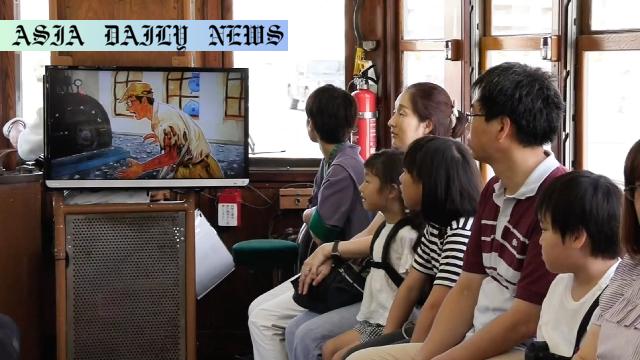Hiroshima children learn about water service restoration after atomic bombing.
Hiroshima’s Waterworks Bureau conducted an educational event for children.
Children heard stories about the restoration of water after the atomic bombing.
A historic streetcar from the bombing acted as the venue for the lesson.
Participants learned about resilience and efforts by engineers post-bombing.

Introduction: A Lesson from Hiroshima’s History
In a heartfelt tribute and effort to educate future generations, Hiroshima’s Waterworks Bureau hosted a unique learning experience to commemorate the 80th anniversary of the atomic bombing. Designed especially for children and their families, this event took them back 80 years to the times of unparalleled resilience and unity that followed one of the darkest moments in history. The event underscores the significance of remembering such pivotal moments while imparting the value of hard work, cooperation, and hope in adversity.
The Significance of the Streetcar as a Learning Setting
The educational journey took place on a profoundly historic vehicle—a streetcar that was operational during the atomic bombing, and later repaired. Serving as a poignant symbol of Hiroshima’s resilience, this streetcar provided more than just a mode of transport; it became a moving classroom that accentuated the importance of preservation, remembrance, and progress. Families boarded this historic streetcar, immersing themselves in narratives of determination and collaboration after the catastrophe.
Heroic Efforts to Restore Hiroshima’s Water Supply
Central to the event was the story of workers who heroically restored the city’s water service after the bombing devastated the infrastructure. An engineer, badly burned from the attack, worked relentlessly amidst shattered machinery, prioritizing the safety and well-being of the residents over his own injuries. This tale of bravery and dedication captivated the young attendees, illustrating the unwavering resilience in the face of unimaginable tragedy.
Impact on Young Participants and Families
The children and parents who attended the event left with a deeper understanding of their city’s history and the vital role played by individuals in the aftermath of disaster. A second-grade boy expressed admiration for the individuals who worked on the water service, calling them “cool” and appreciating the simple joy of drinking safe water. Parents shared how this firsthand learning experience in the exact location of such pivotal events was invaluable for fostering empathy, understanding, and a connection to history among the younger generation.
Preserving and Teaching Historical Resilience
Hiroshima’s efforts to educate the youth about its past are not merely about recounting a tragic event but about drawing inspiration from it. The story of restoring water post-bombing exemplifies the indomitable spirit of humanity and the power of working towards collective wellbeing. By teaching children about the commitment and courage that transformed Hiroshima into what it is today, the city ensures the lessons of the past serve as a guiding light for generations to come.
Conclusion: A Legacy of Hope and Perseverance
As Hiroshima marks 80 years since the atomic bombing, this educational initiative serves as a poignant reminder of the resilience and courage that define its history. Teaching children through such firsthand and immersive experiences ensures the legacy of those who sacrificed and persevered remains alive. Indeed, this serves not only as a lesson from the past but as a beacon of hope for the future, instilling the importance of unity, hard work, and compassion in young minds.
Commentary
Reflecting on Resilience and Education in Hiroshima
The educational event in Hiroshima is a testament to the city’s commitment to preserving and sharing its history with future generations. By using such a remarkable platform—the historic streetcar—the organizers created an intimate and impactful setting for children to engage with the legacy of resilience that defines Hiroshima. It is a reminder that history, when taught with depth and emotion, can cultivate a profound connection between the past and the learners of today.
The Inspirational Power of Everyday Heroes
The story of restoring water in the aftermath of the bombing is incredibly moving. It highlights how, even in the face of personal injury and destruction, individuals rose to the occasion with determination and courage. These unsung heroes exemplify the power of human spirit and community, serving as inspirational figures for the younger generation. Their sacrifices and hard work underscore the importance of selflessness and the crucial role that everyday heroes play in shaping history.
Encouraging Empathy and Awareness Among Youth
Events like this offer children an opportunity to develop a deeper sense of empathy and awareness for historical events that have shaped their world. It’s fascinating to see even a second-grade boy recognize the value of the lesson and express admiration for the efforts of those who rebuilt Hiroshima. Such moments highlight the importance of instilling these values at an early age, ensuring that young people grow with an awareness of the sacrifices made before them.
Concluding Thoughts
Hiroshima’s approach to teaching history is commendable and serves as an example to cities worldwide. By blending storytelling, personal connections, and immersive experiences, the city not only preserves its narrative but fosters a sense of responsibility and hope in its youth. It reminds us all of the power of resilience, the value of remembering the past, and the collective duty to build a better future based on those lessons.


